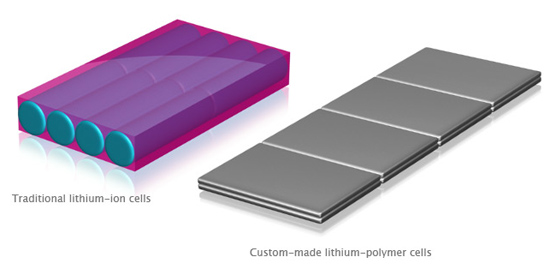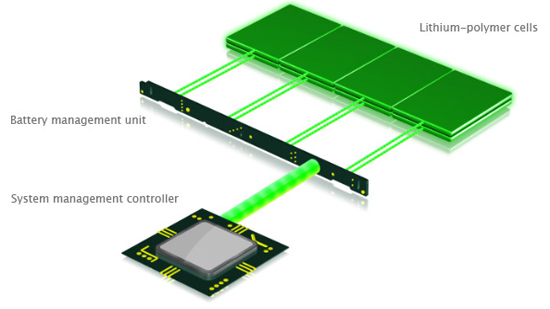Apple's 2009 MacBook Pro: Battery Life to Die For
by Anand Lal Shimpi on June 12, 2009 12:00 AM EST- Posted in
- Mac
I was so focused on the iPhone 3GS and Snow Leopard announcements from this year’s WWDC that I almost missed the gravity of the MacBook Pro announcements.
Apple announced price drops on nearly all of its laptops. The new lineup looks like this:
| MacBook | MacBook Pro 13-inch | MacBook Pro 15-inch | MacBook Pro 17-inch | |
| CPU | Core 2 Duo 2.13GHz | Core 2 Duo 2.26GHz | Core 2 Duo 2.53GHz | Core 2 Duo 2.8GHz |
| GPU | NVIDIA GeForce 9400M | NVIDIA GeForce 9400M | NVIDIA GeForce 9400M | NVIDIA GeForce 9400M + 9600M |
| Memory | 2GB DDR2 | 2GB DDR3 | 4GB DDR3 | 4GB DDR3 |
| HDD | 160GB | 160GB | 250GB | 500GB |
| Battery Life | Up to 5 hours | Up to 7 hours | Up to 7 hours | Up to 8 hours |
| Price | $999 | $1199 | $1699 | $2499 |
If you want an all aluminum body, you have to buy a MacBook Pro. There’s only a single MacBook model and it’s the white chassis that’s been around for a while now.
Apple added a 13” MacBook Pro to the lineup to fill in the gap, although it’s not clear to me whether this 13” MacBook Pro uses the same LCD panel as the old 13” aluminum MacBook or a derivative of the 15” MacBook Pro’s panel, which is superior.
 Of course there are different models within each one of these categories that you can purchase, but they are irrelevant to the discussion we’re about to have. Look at the battery life row in the table above; Apple is claiming up to 7 hours of battery on the new MacBook Pros. The old specs used to be up to 5 hours.
Of course there are different models within each one of these categories that you can purchase, but they are irrelevant to the discussion we’re about to have. Look at the battery life row in the table above; Apple is claiming up to 7 hours of battery on the new MacBook Pros. The old specs used to be up to 5 hours.
Apple did some clever work on its own here. Standard lithium ion batteries are made up of cylindrical cells, similar to AA batteries. The problem with these batteries is that they waste a lot of space within a notebook (try cramming a lot of cylinders into a box, you end up with wasted space). This wasted space translates into larger batteries than are necessary, which makes for larger notebooks.
In order to continue to drive laptop thinness down, Apple started experimenting with using custom lithium polymer batteries instead of the industry standard lithium ion parts. Lithium polymer cells aren’t made of cylindrical cells (they’re rectangular), so there’s no wasted space. Not only does this make the batteries more compact, but it also gives you greater capacity since you’re using all available chassis volume for the battery.

Makes sense. Courtesy, Apple.
Apple also found that it was wasting space in the removable enclosure for the batteries as well, so its lithium polymer offerings are no longer user removable. I suspect this part of the equation has more to do with cutting costs than saving space though.
Apple first used this lithium polymer battery technology in its MacBook Air. It gave Apple a very thin battery that allowed it to create the MacBook Air’s sweet form factor. Then came the new 17” MacBook Pro, without a removable battery. Apple claimed that this battery would last for five years before it needed replacing and resulted in up to an 8 hour battery life.

The extended life is supposedly due to an on-battery sensor that communicates with the system's management controller that can dynamically sense the needs of each lithium polymer cell and feed that info back to the charging circuitry. The result is slight variations in charging current designed to optimally charge each and every cell; apparently reducing wasted charge cycles significantly. Apple claims that most cells will hit 80% of their life after 200 - 300 charge cycles, but its special lithium polymer batteries will hit the 80% mark after as many as 1000 charge cycles. Apple claims its unique battery chemistry and microprocessor managed charging (Adaptive Charging) is responsible for these gains but it’s a difficult statement to prove; we’ll have to wait and see what happens after a few years of use.










113 Comments
View All Comments
RikkiTikkiTavi - Monday, June 15, 2009 - link
Interesting. As I said my expertise on the mater is limited. It would be interesting to know what reasons there are for cylindrical cells.As I see it, they are more inefficient in both space usage and manufacturing. I'll see if I can find something on this.
santala - Saturday, June 13, 2009 - link
Indeed, the older Macbook batteries contain flat rectangular cells, which was plain to see once opened. Therefore the comparison used by Apple currently, which leads you to believe that they used to be cylinderical, is wrong. They have been rectangular on Macbooks before, the material and size simply has changed, not the shape of the cells themselves.PlasmaBomb - Saturday, June 13, 2009 - link
My apologies, you are indeed correct... browsing my pics folder came up with the answer-http://pics.bbzzdd.com/users/PlasmaBomb/PowerBook....">http://pics.bbzzdd.com/users/PlasmaBomb/PowerBook....
Old powerbook = cylinders (NiMH I think).
http://pics.bbzzdd.com/users/PlasmaBomb/Mackbook.j...">http://pics.bbzzdd.com/users/PlasmaBomb/Mackbook.j...
Macbook = flat cells
(feel free to take a copy of the pics)
So they haven't used cylindrical cells for a long time, bad apple for deliberately misleading people :|
Sorry as I said I don't have a macbook to play with :(
The lithium ion battery from my laptop looked pretty much like this -
http://static.howstuffworks.com/gif/lithium-ion-ba...">http://static.howstuffworks.com/gif/lithium-ion-ba...
when I dismantled it (it was dead).
evilspoons - Friday, June 12, 2009 - link
I have a Mid-2007 15" MacBook Pro (Santa Rosa 2.2 GHz) with 3 GB of RAM and a 500 GB hard drive (both upgraded by me from 2 GB - the extra 1 GB was free, otherwise I'd have 4 GB, and the 120 GB hard drive it came with was awful).Most of the time the battery life is just fine - but damn, this new 15" will DOUBLE what mine gets? Wow!
I think the new 15" MBP - in matte - with 4 or 8 GB RAM, a 512 GB SSD (or a 128 GB plus a hard drive, if there somehow was room: I need my iTunes library!), and maybe with the upcoming quad-core laptop CPUs would make just about the perfect computer.
Hopefully this is what the next generation MacBook Pro will look like and it'll be out about the time I start wishing my 2.2 GHz was faster.
jeffbui - Friday, June 12, 2009 - link
Anand, I'm sure you've put in that X25-M. Let us know how much more battery life the notebook gets. Thanks!JarredWalton - Friday, June 12, 2009 - link
My understanding is that the X25 is a high performance part that doesn't dramatically improve battery life. However, it should be better http://www.anandtech.com/storage/showdoc.aspx?i=34...">by about 6%, give or take.PlasmaBomb - Friday, June 12, 2009 - link
Still 6% of 8 hours is a decent amount...about an extra half hour.
cserwin - Friday, June 12, 2009 - link
As a modeler of RC airplanes, I know that LiPO's require extreme caution, especially when charging. Search youtube for "LiPO Fire".Basically, if you charge the batteries too fast, they burn. Could the smaller brick have to do with battery charging rates?
mmntech - Friday, June 12, 2009 - link
I'm an RC pilot as well and IMO, the safety risks with LiPo packs have been greatly exaggerated in recent years. Most laptops and other portable consumer electronics devices these days already use Li-Ion or LiPo as is. All packs do have a serious risk of explosion and fire, but they usually don't spontaneously combust unless they're cheaply made and have internal faults. Remember that RC packs are rated for much higher performance than laptop packs. They're also subject to more stress in the form of vibration and hard impacts. In 99.9% of cases, they're safe in consumer electronics provided they aren't abused.The batteries used for laptops have built in charge circuitry and balancers.
PlasmaBomb - Friday, June 12, 2009 - link
That is what the chip in the battery and charging controller are for.